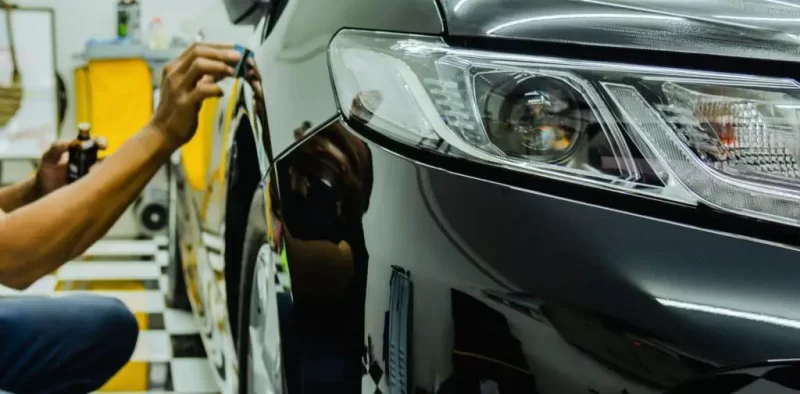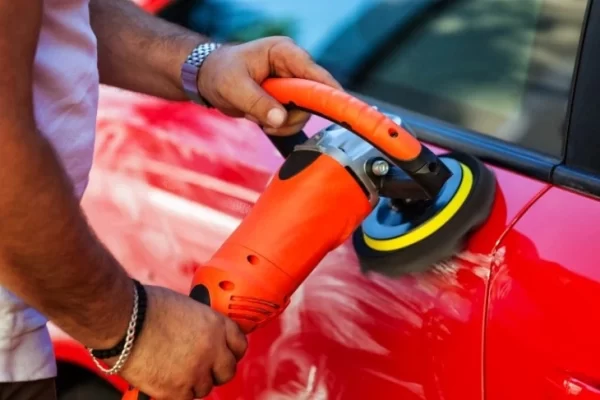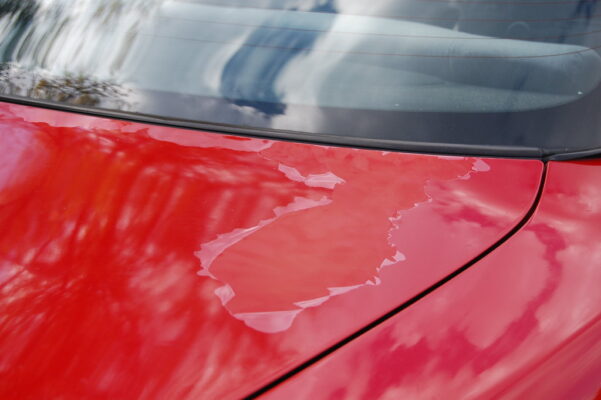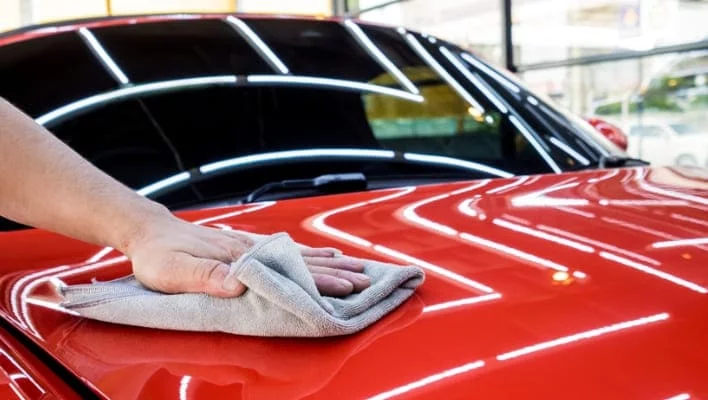Can you paint over clear coat? Yes, you can, but proper preparation is key. Start by lightly sanding the existing clear coat to remove its shine and create a rough surface for the new paint to adhere to. Ensure the surface is completely clean of dirt and grease.
Apply a base coat if needed for colour consistency, followed by thin, even layers of car paint. Allow each layer to dry before applying the next.
Finish with multiple thin clear coats to protect the paint and enhance the shiny appearance. This process helps maintain the car’s finish and durability.

Can you paint directly over clear coat without sanding?
While it might be tempting to skip the rubbing process and dive straight into a fresh paint job, painting directly over a clear coat without proper preparation is likely to result in a subpar finish.
The base coat is designed to be incredibly smooth and glossy. This shiny surface doesn’t provide enough “tooth” for paint to adhere properly. Without sanding, the paint may peel, chip, or look uneven.
To achieve a durable and professional-looking paint job, you’ll need to create a rough surface for the paint to grip. This is where the sanding process comes in.
Using a sanding block and wet sandpaper, you’ll gently scuff the clear coat to create a slightly rough texture. This process, often referred to as wet sanding, helps ensure that the spray paint coat bonds securely to the existing surface.
If you have deep scratches in the base coat, sanding is even more crucial. By beginning sanding and gradually progressing to finer grits, you can remove imperfections and create a smooth base for your paint.
Remember, proper preparation is key to a successful job. Taking the time to sand the clear coat will help you achieve a long-lasting and attractive finish.

How do you prepare a clear coat surface for painting?
First, assess the clear coat’s condition. If it’s glossy and free of deep scratches, wet sanding might suffice. Wet sanding involves using fine-grit sandpaper with water to smooth the clear coat’s shiny surface.
However, for an old clear coat with imperfections or if you’re aiming for a complete paint job, removing all the clear coat is necessary.
To remove the clear coat, use a sanding block with progressively finer grits of sandpaper. Start with a coarser grit to remove the thick layers and gradually switch to finer grits for a smoother finish. This process can be time-consuming, but the paint must adhere properly.
Once the clear coat is removed, clean the surface thoroughly with a microfiber cloth to remove dust and debris. If the paint underneath is in good condition, you can apply primer directly. Primer helps the paint adhere better, especially when painted over clear coat.
If the paint underneath is damaged or you want a fresh start, remove the old paint completely. This ensures a clean slate for your new paint job. After removing the old paint, apply a primer coat to seal the surface and create a base for the paint.
When you apply primer, let it dry before moving to the next step. Sand the primer lightly to create a tooth for the paint to grip. This prevents orange peel, a common issue in diy painting.
Finally, it’s time to apply paint. Use high-quality paint and apply it in thin, even coats. Allow each new coat to dry completely before applying the second coat. For a professional-looking finish, consider sanding between coats to remove imperfections.
Is primer necessary when painting over clear coat?
While it’s possible to paint over clear coat directly, using a primer is generally recommended for optimal results.
Adhesion
Primer dries a better bonding surface for the paint to adhere to. The clear coat is a glossy, smooth surface, and the paint may not stick as well without a primer.
Hiding power
If you’re covering a dark colour with a lighter one, a primer can help hide the old colour, preventing multiple coats of paint.
Protection
It acts as a barrier between the paint and the new, helping to prevent rust and other issues.
Filling imperfections
It can help fill in minor scratches or imperfections in the clear coat before applying the clear coat.
How do I remove fresh paint from a car’s fresh coat?
Assess the damage: before starting, determine the extent of the paint. If it’s a small area, you might be able to remove it without sand. However, for larger areas or multiple layers of spray, you’ll likely need to wet sand.
Protect the surrounding area: use masking tape to cover areas around the paint to prevent accidental damage.
Start with gentle removal: try using a microfiber towel dampened with warm, soapy water. Gently rub the area in a circular motion. For stubborn spots, you can try a mild rubbing compound or a dedicated paint removal product.
Wet sand for heavier damage: if the paint is embedded in the clear coat, sand might be necessary. Begin with a fine-grit sandpaper and gradually move to finer grits. Be careful not to sand through the clear coat to the base coat.
Consider a new clear coat: if the clear coat is significantly damaged, you might need to apply a new clear coat to restore the car’s shine and protect the car paint.
Prevention is key: to avoid future paint mishaps, consider parking your car in a garage or using a car cover when it’s not in use.

Should I wet sand between coats when painting over clear coat?
When deciding whether to wet sand between coats while painting over a clear coat, it’s important to understand the process and its benefits. Can you paint over clear coat? Yes, you can, but proper preparation is key to achieving a smooth and durable finish.
First, ensure that the clear coat is in good condition and not peeling or flaking. If the clear coat has significant imperfections like orange peel or scratches, you might need to remove the clear coat or at least sand it down to smooth the surface.
To begin, sand the clear coat with fine-grit sandpaper to create a slightly rough surface. This helps the paint adhere better. You don’t need to sand off all the clear coat—just enough to dull the glossy shine. Use a back-and-forth motion while you sand, and ensure the surface is smooth and free of dust before applying paint over clear coat.
Wet sand between coats can help achieve a flawless finish. After applying the first coat, allow it to dry completely. Then, begin sanding lightly with fine-grit sandpaper (usually 1,000 to 2,000 grit).
This step helps to smooth out any imperfections like minor bumps and prepares the surface for the next layer of car paint. Use water to lubricate the surface while you sand, which reduces the risk of scratching the car paint and removes dust particles.
What do you do after wet sanding?
After rubbing, clean the surface thoroughly to remove any residue before applying subsequent coats. This ensures that the car paint will stick properly and car paint evenly. Continue this process of painting and wet sand until you achieve the desired colour and coverage. Typically, multiple coats are needed to get an even.
Finally, if you’re painting over a previously painted surface or adding a new color, make sure the surface is prepared correctly. This might involve sand down to the bare metal if there are layers of car paint that are chipping or peeling. Ensure you’ve applied enough paint to wrap any underlying colours or imperfections.
Once the final coat of car paint is applied, you can finish with a top coat of clear coat to protect the paint and add a glossy shine. This clear coat should be applied in several thin coats, with drying time between each to avoid orange peel and other imperfections. For a flawless finish, some professionals also recommend wet rubbing and polishing the final clear coat layer.
In summary, painting over a clear coat involves careful preparation and layering to achieve a smooth and durable finish. Wet sand between coats helps ensure an even application and a professional look on your car’s body panels.

What are the common problems that can occur when painting over a clear coat?
When painting over clear coat, several common problems can arise if the process isn’t done correctly:
Poor adhesion
One of the main issues is poor adhesion of the new paint. If the clear coat isn’t properly painted, the new paint may not stick well, leading to peeling or flaking over time. This problem can be exacerbated if the existing clear coat is worn or damaged and not fully removed or adequately prepared.
Colour mismatch or uneven coverage
Applying a new base coat over an old clear coat can sometimes result in uneven colour coverage or a mismatch, especially if the clear coats aren’t applied evenly. This is more noticeable in light or metallic colours and can ruin the aesthetic of the car.
Surface imperfections
Any imperfections in the existing clear coats, such as scratches, dents, or chips, will likely show through the new paint layers if not properly addressed.
It’s important to remove clear coat around these areas and repair any damage before applying new paint.
Bubbling or blistering
This can occur if the surface isn’t clean or if there’s moisture trapped beneath the new paint layer. These bubbles or blisters can ruin the finish and may cause the paint to lift from the body panel.
Orange peel texture
An uneven application of clear coats or inadequate drying times between layers can lead to an “orange peel” texture, where the spray paint doesn’t lay smooth. This can detract from the car’s appearance and may require rubbing and reapplication to fix.
Peeling or chipping
If the car paint over clear coats isn’t applied correctly, it may peel or chip off, especially in areas exposed to regular wear and tear. This is often due to poor surface preparation or insufficient car paint thickness.

Conclusion about the paint job
In conclusion, painting over clear coats can effectively refresh and enhance your car’s appearance if done correctly. Start by rubbing the clear coat shiny surface to remove the gloss and ensure the spray paint adheres well.
It’s crucial to prepare the surface correctly, addressing any other imperfections that might affect the final finish. Depending on the colour change, applying a base coat of paint can help achieve uniform coverage across the body panel.
When you paint over clear coat, spray the paint in thin, even layers, allowing sufficient drying time between each layer to prevent issues like runs or uneven texture. After the colour coats, apply several new clear coats to protect the painted surface from wear and environmental elements, preserving the car’s finish. This approach ensures that the new paint adheres well and provides a durable, shiny appearance, maintaining the integrity of your car’s exterior.

Matthew Edward is a professional painter who loves to paint and wants to share useful tips and tricks which he had learned in many years of experience in painting. He also used many products that can be used for painting he has tried and tested each and every product to give an unbias opinion about it in his review. This blog is very useful for those newbies who want to learn painting without making mistakes.






